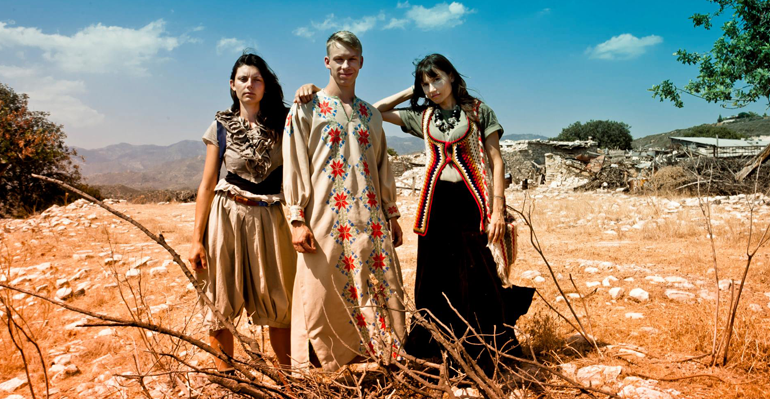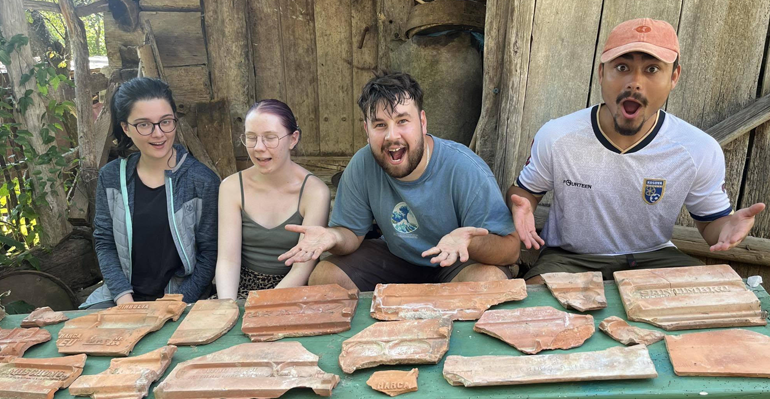
A Shepherd’s Life in the Cypriot Mountains
Introduction:
Cyprus is still an important place to hear about ancient shepherds and meet some modern-day ones. It’s even possible that some of the earliest ‘farm animals’ were domesticated mouflon, 8,000 years ago, here in this multi-faceted island. Most Cypriots eat sheep/ goat cheese and yogurt, pretty much every day. Less than 100 years ago, there were about 40 shepherds in Kato Drys, now very few.
Come to Cyprus to briefly live the life of a shepherd, hearing stirring tales, maybe milking a goat, walking through the aromatic ‘maquis’ landscape and almost certainly eating the famous cheeses, ‘halloumi’ and ‘ánari’, after first witnessing them being made. We even give you the chance to explore ‘Shepherd Inspired Fashion’.
This ‘Shepherd’s Heritage Trail’ in Larnaca district’s mountainous region, is offered by Kato Drys Community Council and their stakeholders, Mola Culture Factory. Find the link to the map of the trail below, or contact the Mola Culture Factory for more details.
What you'll discover:
Kato Drys Village
At stop one, you will hear the tale of the “Foxes of Kato Drys” sat in the local coffee shop in the beautiful village of Kato Drys. Traditional skills students working with woodcarvers made a beautiful sculpture of a running fox with its tail on fire; it hangs by the coffee shop. Have a coffee (we suggest ‘Cyprus coffee’) and hear the tale, which involves painting the church with yogurt!
St Spyridon’s Chapel
Then, you will go in a 7-seater 4WD vehicle, down a farm road to St Spyridon’s chapel and hear the story of this much revered saint, a modest man who herded his animals and wore a simple shepherd’s hat.
Panayia Milianiotissa Chapel
Continuing in the 4WD vehicle, you will visit another chapel, Panayia Milianiotissa, this one is ruined and has been subject to an interesting archaeological excavation under in-struction from the Priest. The shepherd’s village Milianiotissa close to the church was abandoned long ago. It is one of the ‘lost villages’. It’s a good place to discuss the decline of traditional shepherding.
Loulla’s Farm
On the farm track from Kato Drys to Choirokoitia, we will be looking out for interesting and useful wild plants. Of course, what you see depends on the season but there’s always something to discover.
- Locally called “Spalathkia” (in Latin “Calicotome villosa”), a tough spiky bush with resin that makes it insect proof. It was used as a base in the ceiling/ flat roof, for the clay to stick to.
- Locally called “Throubi” (in Latin “Thymus capitatus”), Wild Mediterranean Thyme which was used to treat several diseases and as a flavoring in cooking. The leaves of “Throubi” are used in various foods to add aroma but also because of their antitoxic properties. Also used in roof spaces to deter insects. In Ancient Greece soldiers bathed in a bath with thyme for anointing and protection.
- Locally called “Esteva” (in Latin “Cistus ladanifer”) is an aromatic shrub with white or pink rose-like blooms, occasionally lilac coloured. A tea from it reduces high blood pressure and it is used for women’s ailments, such as heavy periods and to treat cystitis (it gives the disease its name).
- Locally called “Dakria tis Panagias” (Tears of Mother Mary) or “Immortelle”, Helichrysum italicum tea detoxifies liver, relieves spasms, stimulates to the gallbladder and is a diuretic. It helps with digestion and relieves gallbladder pain. It is an antispasmodic and is effectively used for smooth muscle relaxation, works as an antiseptic solution and is traditionally used to treat conditions related with the respiratory tract.
Why this trail matters:
- The story and the experience will help to stimulate the local economy in a sustainable way.
- Visitors will learn more about the local cultural landscape that few tourists see.
- Discovery by tourists, from Cyprus and abroad, will raise awareness of the need for recognition and protection of vernacular patrimony.
The experience will help visitors recognise similarities between rural areas from all over the world and encourage a greater sense of oneness through social mediation.
Heritage Trail Map:
Heritage Trail Details:
- Length (km): about 14 km
- How it could be undertaken: driving; locals use their cars but the farm track is quite rough and care is needed. Use of a 4WD vehicle would be better (Mola Culture Factory can appoint a guide with such a vehicle). The farm track can be walked but you would need to re-trace your steps, as walking back along the national road is not advised.
- Special notes (clothes, equipment, weather, etc.): Between the end of October and the end of March, rain is possible and a light raincoat is needed plus a warmer jumper of fleece. At all times wear a hat, even in winter the sun can burn and in Spring, Summer and Autumn, sunburned is commonplace. You should also wear sun cream of over factor 40, especially if not between end of October and end of March. If walking you need strong shoes with good ankle protection. Do not walk into the ‘maquis’; it is prickly and unyielding.
- Safety guidelines: Follow the rules about clothing and staying on the track. Cyprus has a few quite dangerous examples of wildlife but injuries are extremely rare. There is one very venomous snake, a blunt-nosed viper. Snakes lay in the sun to warm up, you spot them on the track; stamp your feet and they slither away. A black whipsnake is common and is not venomous. None of the 6 types of lizards that you might see, are any problem. Do not randomly turn over stones because there are venomous centipedes and scorpions but their bite is not worse than a bee sting. Do not walk off into the maquis, in case you come suddenly upon a snake. All in all, the wildlife is fascinating and if you take care, is not a threat.
- Guiding:
- This trail can be completed alone, or with a guide.
- To book a guide, please contact The Old Olive Mill – Mola Culture Factory
Contacts for more details:
Mola Culture Factory
https://www.facebook.com/molalefkara/
Address: Saint Onoforus 1, Pano Lefkara, 7700, Larnaca District, Cyprus
Phone: +357 99739320
Email: martinclark6@aol.com
Quests / Chances to be creative:
Quest 1: 'Making St Spyridon’s Hat'
This is a one-day course, with breaks for lunch and tea/coffee. The venue is the Old Olive Mill (Mola Culture Factory). In all the icons of Spyridon he wears a traditional shepherd’s hat. The making of the hat is a variation of making a beehive / skep and a flat traditional Cypriot basket, a ‘tsestis’. Traditionally they were made in farming areas from long wheat straw but since the advent of combine harvesters that chop straw, there has been a switch to wild grasses and banana leaf.
The process involves laying the grass out and wrapping it to produce an even width ‘cable’, which is then coiled into a flat shape for a mat but indented for a hat. There are other names in Cyprus, a “sele” or “sofra”. The word “sofra” actually means the flat surface of a dinner table, and in the Mesaoria district, the locals still do eat their meals from this salver. Elsewhere in Cyprus, these hand-woven trays with striking geometric designs are considered such works of art that they don’t use them, but instead hang them on the wall as decoration!
Quest 2: 'Shepherd-Inspired Fashion'
This idea came about in a strange way. In 2012, on a lonely road in Romania’s Trascau mountains, the founder of Mola came upon a shepherd. Although it was early summer and quite warm, he was wearing his traditional wool cloak and he had descended the mountain from quite high up. The founder learned French and Latin as a schoolboy, so Romanian was okay for him! He asked to take a photograph and the shepherd obliged. The picture was posted on Facebook and the famous UK fashion designer, Vivienne Westwood saw it; she asked her stylist, Stevie Westgarth, to make contact. All over the Balkans, such coats are in everyday use, even today. Shepherds, often nomadic, were becoming a focus for some fashion designers, and the ‘Shepherd-look’ or ‘Nomad-look’ was taking off. For the founder, that look has some defining features…
- Clothes in natural colours – perhaps dyed with plant, mineral or even animal pigments.
- Layering, so the shepherd can take off layers as the cold night transforms into hot noonday sun.
- Loose fitting to allow movement.
- Use of leather, sheepskin, and wool + other natural fibres (cordage from grasses and tree bark for example).
- Simple adornment including fringes, tassels and chunky jewellery from found objects.
- Freedom, confidence and good health. Undoubtedly, shepherds are ‘long-lived’!
- A sense of romance, adventure and poetry – shepherds became famous authors, poets and pioneers.
- Being in control of your own time and destiny.
- Rooted in culture and nature, in-tune with the cultural landscape.
- Not a slave to time but going with an easier pace of life and a more natural lifestyle with healthy eating, etc.
- The wearing of masks by shepherds to guard again insects – we glamorized this aspect a bit!
Since the first correspondence, meeting with and working with Stevie Westgarth, the Mola team have done photoshoots and events in Romania, Slovakia, Cyprus and Turkey.
As part of this Shepherd’s trail, the fashion is an optional element and adds a day and a night to the experience. Mola keeps a wardrobe of shepherd inspired clothes and often use Loulla’s farm or the abandoned shepherd’s village of Drapkea close to Kato Drys. For photoshoots.


